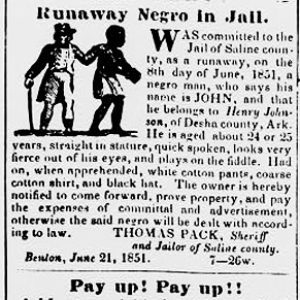calsfoundation@cals.org
Slave Codes
Slave codes were the legal codification of rules regulating slavery. These official parameters for slavery were enacted in every colony or state that condoned the institution. Even before Arkansas was a recognized territory, slave codes existed in the region. Adopted by the French in 1724, the Code Noir, or Black Code, set the legal structure of slavery in Louisiana during the French and Spanish periods. The Code Noir was a comprehensive and detailed policy that set forth guidelines for almost every facet of slavery. The initial laws were partly designed to set limits upon slave owners and convey certain responsibilities to the masters regarding their slaves, including setting minimal standards for food, clothing and shelter, long-term care of sick or elderly slaves, and rules for converting slaves to Catholicism. The Code Noir also set acceptable forms of punishment for slaves, as well as for masters who did not adhere to these regulations. An example of one of the more cruel punishments in this code, directed toward slaves who attempted to run away from their owners, was branding with a fleur-de-lis on the shoulder and cutting off the ears.
After the Louisiana Purchase in 1803 shifted control of the region to the United States, the legislature of the newly formed Louisiana Territory enacted a comprehensive set of laws pertaining to slavery in 1804, using the 1724 Code Noir as a model. The 1804 code eliminated some of the more ruthless features of the Code Noir such as branding and the cutting off of ears while keeping the emphasis on the responsibility of the master for the actions of his slaves firmly in place. Several additional slave laws were passed during the time between 1804 and 1835, the last full year of Arkansas’s territorial status, including a regulation passed in 1825 creating a slave patrol. The patrol was composed of white male citizens charged with inspecting slave quarters and searching for unlawful assembly. These patrols were a central feature in Arkansas communities with large slave populations until after the Civil War. In 1835, Governor John Pope appointed lawyers John Steele and James McCampbell to compile all of the regulations passed since 1804 into a digest of Arkansas laws. This digest included all of the slave laws enacted by the previous territorial governments. Slaves were forbidden to carry guns, to assemble with slaves of other owners, to be away from an owner’s property without a pass, to buy or sell any commodity, to obtain liquor, or to associate with whites without the master’s permission.
Arkansas was admitted to the Union in 1836 as a slave state. In 1837, the state’s first legislature passed a comprehensive slave code to regulate slaves, slavery, and free blacks. By law, a slave was technically categorized as personal property. Similar to cattle, horses, or other types of possessions, slaves formed part of the owner’s estate that could be sold, traded, or passed down to heirs. However, the law recognized slaves as a unique form of property that could not be dealt with in the same way as livestock or other property. Slaves had to be controlled, and the slave code attempted to achieve that goal by providing a set of restrictions and punishments for slaves and those in contact with slaves.
The slave code incorporated many of the rules in place from the territorial period and also borrowed heavily from slave codes of other Southern states. The 1837 Arkansas slave code, found in the 1838 Revised Statutes of the State of Arkansas, provided the framework within which slavery existed in the state. The 1837 code contained thirty-five sections that outlined various restrictions on slaves and those associating with slaves, along with prescribed punishments for offenses, most often in the form of whippings or “stripes.” The following are four examples of statutes found in the 1837 Arkansas slave code:
Sec. 23. Any gun or other offensive or defensive weapon found in the possession of a slave, without having the written permission of his master to carry the same, may be seized by any person, and upon proof of such seizure before a justice of the peace of the county where the same shall have been made, such gun or weapon shall be by the order of such justice, adjudged and forfeited to the seizor [sic] for his own use, and such slave shall receive by the order of such justice, any number of stripes not exceeding thirty.
Sec. 27. If any white person, or free negro or mulatto, shall be found in the company of slaves, at any unlawful meeting, or shall harbor or entertain any slave, or shall be found drinking or gaming with any slaves, without the consent of the owner or overseer of such slave, such white person, free negro, or mulatto shall forfeit and pay a sum not exceeding one hundred dollars, and shall receive any number of stripes not exceeding thirty.
Sec. 28. Every justice of the peace, upon his own knowledge of any unlawful meeting of slaves, white men, free negroes and mulattoes, or on information whereof, shall forthwith issue his warrant to apprehend such slaves, white men, free negroes or mulattoes, and cause them to be brought before himself or some other justice of the peace, to be dealt with according to law.
Sec. 29. Sheriffs, coroners and constables, upon a knowledge or on information of any unlawful meeting of slaves, white men, free negroes or mulattoes, or of any riot, rout, or unlawful assembly of slaves, shall suppress the same, and without warrant take the offenders before some justice of the peace of the county, to be dealt with according to law.
Between 1837 and 1861, additional restrictions were enacted on slaves and free blacks through legislative acts and judicial decisions. The slave code became increasingly harsh as the number of slaves in the state increased and fears of slave uprisings grew. In 1843, a law prohibiting further immigration of free blacks into Arkansas was enacted. This law also required blacks already residing in the state to post a $500 bond and to produce evidence of freedom. In 1859, the Arkansas legislature passed a law stating that any free black person over the age of twenty-one was barred from living in the state unless they enslaved themselves to a master.
The slave codes in Arkansas evolved over time and were adapted continuously to meet the needs of slave owners. In reality, the actual treatment of slaves depended much more on the individual slave owner than the slave codes, but the slave codes did set the legal parameters for slavery in Arkansas.
For additional information:
Bolton, S. Charles. “Slavery and the Defining of Arkansas.” Arkansas Historical Quarterly 58 (Spring 1999): 1–23.
Cathey, Clyde Winfrey. “Slavery in Arkansas.” Master’s thesis, University of Arkansas, 1936.
Jones, Kelly Houston. A Weary Land: Slavery on the Ground in Arkansas. Athens: University of Georgia Press, 2021.
Taylor, Orville W. Negro Slavery in Arkansas. Fayetteville: University of Arkansas Press, 2000.
Chris M. Branam
Cabot, Arkansas
 Arkansas General Assembly
Arkansas General Assembly Civil War through Reconstruction, 1861 through 1874
Civil War through Reconstruction, 1861 through 1874 European Exploration and Settlement, 1541 through 1802
European Exploration and Settlement, 1541 through 1802 Louisiana Purchase through Early Statehood, 1803 through 1860
Louisiana Purchase through Early Statehood, 1803 through 1860 Post-bellum Black Codes
Post-bellum Black Codes Runaway Slave Article
Runaway Slave Article 




Comments
No comments on this entry yet.